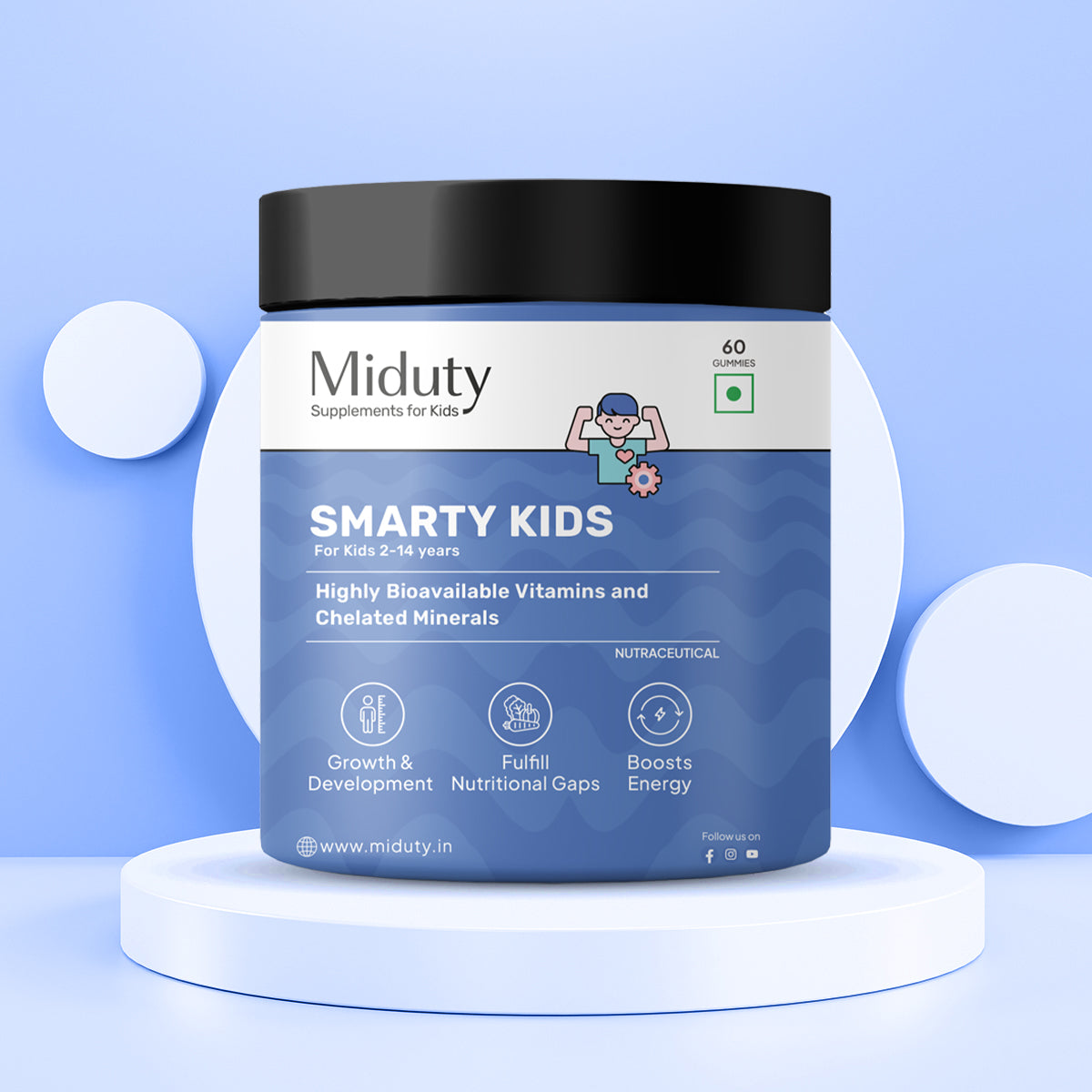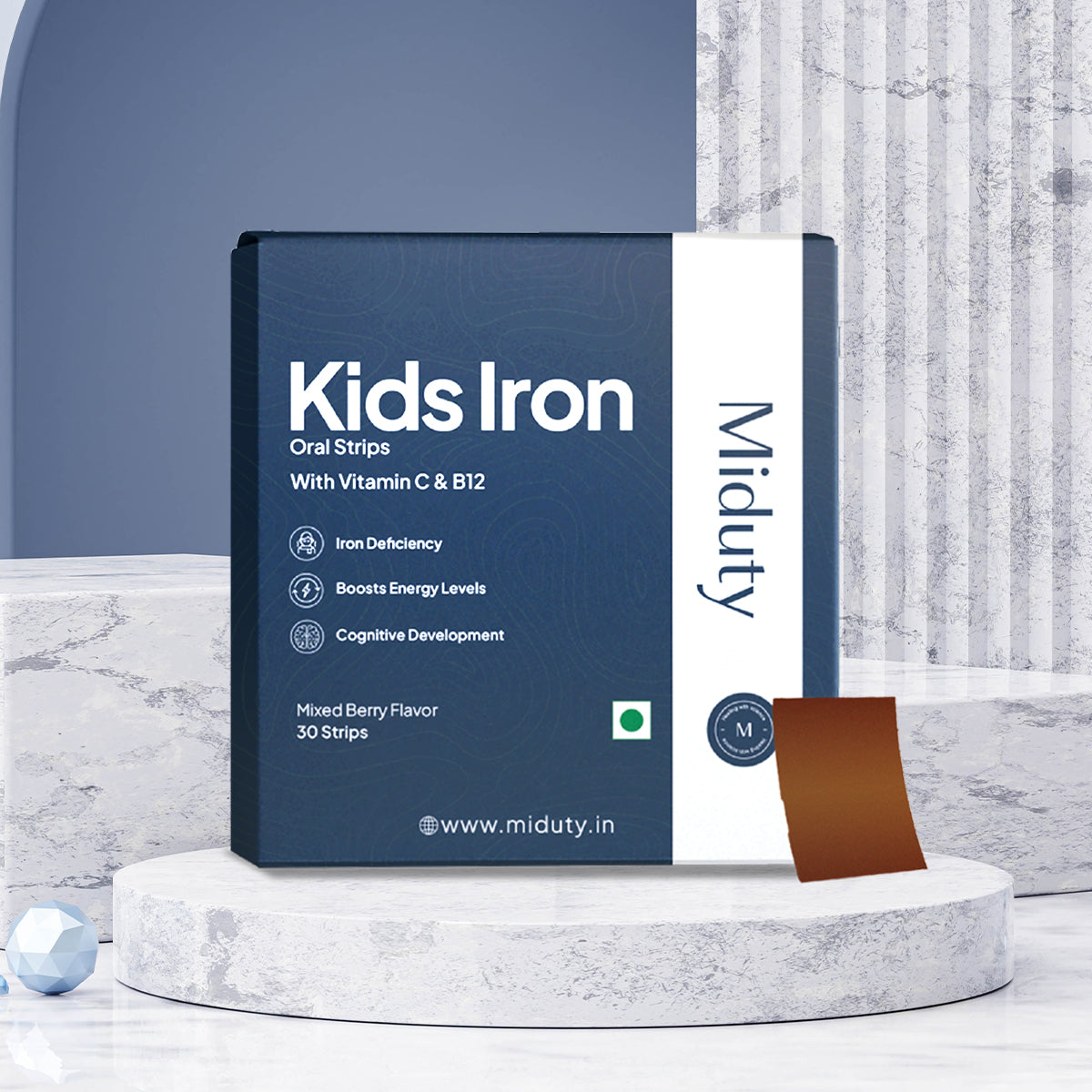
How to Choose the Best Multivitamin for Kids: Ingredients, Age Groups & Different Forms
Childhood is a critical phase of growth, development, and learning. During this period, children experience rapid physical, cognitive, and emotional changes. Unfortunately, in India, many children are still at risk of micronutrient deficiencies due to lifestyle factors, dietary habits, and socioeconomic constraints.
Indian parents increasingly consider multivitamins as a way to bridge potential nutritional gaps. While a balanced diet should ideally provide all essential nutrients, modern challenges such as busy lifestyles, processed foods, picky eating habits, vegetarian diets, and reduced outdoor activity can make it difficult for children to meet all their micronutrient needs. According to the National Family Health Survey (NFHS-5), deficiencies in vitamins and minerals such as iron, vitamin D, and B12 are common among Indian children, affecting growth, immunity, and health.
A research published in the Indian Pediatrics Journal highlights that over 70% of Indian children aged 5-15 have suboptimal vitamin D levels. Iron deficiency anemia affects nearly 50% of children under five, compromising cognitive development and physical stamina. Calcium and zinc deficiencies are also widespread, which can impact bone density, immune function, and growth patterns. [1]
While choosing the right multivitamin, parents must consider age-appropriate formulations, scientifically backed ingredients, safety profiles, and the specific dietary habits of their child. This guide will help parents to select the best multivitamin for kids in India, to support their children's health.
Key Takeaways
1. Up to 80% of Indian children have low Vitamin D levels - Despite abundant sunlight, indoor lifestyles and limited outdoor play leave most kids vulnerable to weak bones and delayed growth.
2. Nearly 50-59% of children under five suffer from iron deficiency anemia. Low iron can affect energy, attention span, and school performance.
3. Over 70% of children aged 5-15 have suboptimal Vitamin D levels, highlighting the urgent need for supplementation alongside diet.
4. Evidence-Based Ingredients -Essential nutrients like DHA, vitamin D, iron, zinc, and B12 have strong scientific backing for supporting immunity, cognitive function, and growth in children.
5. Avoid harmful additives - Excess sugar, artificial colors/flavors, toxic preservatives, and megadoses of fat-soluble vitamins can be harmful; parents always check labels carefully.
What are Kids' Nutritional Needs?
Children's nutritional needs vary significantly depending on their age, growth stage, and activity level. The Indian Council of Medical Research (ICMR) and the World Health Organization (WHO) provide detailed recommendations for micronutrient intake during childhood, which serve as a guideline for evaluating whether a child may need supplementation.
1. Infants and toddlers have high metabolic demands relative to their size, requiring adequate proteins, fats, and micronutrients for rapid growth. During the first two years, nutrients like iron, calcium, vitamin D, and zinc are particularly important for brain development, bone growth, and immunity. For example, iron supports hemoglobin production and cognitive function, while zinc plays a critical role in immunity and wound healing. [2]
2. From age 2 to 5, children enter a period of steady growth and require a balanced mix of macronutrients and micronutrients to support bone and muscle development, energy metabolism, and cognitive function. Calcium and vitamin D continue to be crucial, as bones are rapidly mineralizing, and inadequate intake can predispose children to rickets or other bone-related issues.
3. School-age children (6-12 years) experience growth spurts, higher activity levels, and increasing academic demands. Adequate intake of B-vitamins is vital for energy metabolism, iron for cognitive performance, and vitamin C for immunity. Diets during this period often lack variety, making supplementation a practical consideration.
4. Teenagers (13-18 years) undergo puberty, which triggers rapid physical and hormonal changes. Boys and girls have different nutritional needs during this phase: girls may require more iron due to menstruation, while boys need higher protein and calorie intake for muscle development. Omega-3 fatty acids, calcium, and vitamin D remain important for bone health, while B12 supports neurological development and energy production.
Understanding these requirements is the first step in deciding whether a child might benefit from a multivitamin.
Common Nutrient Deficiencies Among Indian Children
Despite access to sunlight and traditional diets, many Indian children face serious nutritional gaps that impact their growth, immunity, and development.
1. Vitamin D Deficiency: Up to 80% of Indian children have low vitamin D levels, largely due to limited sun exposure, indoor lifestyles, and darker skin. Deficiency can cause weak bones, delayed growth, and a higher risk. [3]
2. Iron Deficiency Anemia (IDA): Affecting nearly 59% of children (ages 6-59 months), iron deficiency leads to fatigue, poor concentration, and stunted cognitive development, directly impacting academic performance. [4]
3. Calcium Deficiency: Low dairy intake and lack of fortified foods contribute to poor calcium levels, leading to weakened bones and delayed skeletal growth. [5]
4. Vitamin B12 Deficiency: Common in vegetarian diets, a lack of B12 can cause fatigue, developmental delays, and neurological issues in children.
5. Zinc Deficiency: Essential for immunity and growth, zinc is lacking in about 43% of Indian children, leading to weakened immune response and growth problems. [6]
Other micronutrients like iodine, magnesium, and vitamin A are also frequently insufficient, further highlighting the need for improved dietary awareness and supplementation.
When Do Kids Need a Multivitamin?
Pediatric guidelines recommend supplementation primarily when diet alone cannot meet nutritional needs which is quite common nowadays or when a child has specific risk factors.
Parents should look out for visible signs of nutritional gaps. Common indicators include:
- Frequent illnesses or infections
- Fatigue and low energy
- Slow growth or weight gain
- Poor concentration or learning difficulties
- Brittle nails, hair thinning, or dental issues
- Delayed milestones in infants or toddlers
Different Age Groups and Their Multivitamin Needs
Children's nutritional requirements change dramatically with age. Choosing the right multivitamin depends on the child's growth stage, activity level, and dietary patterns.
1. Infants (0-2 years)
Infants primarily rely on breast milk or formula for their nutrients. While breast milk provides many essential nutrients, deficiencies in vitamin D and iron are common, especially if the baby is exclusively breastfed. Pediatricians often recommend vitamin D drops for infants to prevent rickets and support bone health. [7] Iron supplementation may be advised for babies born prematurely or with low birth weight. Multivitamin supplementation at this stage should always be doctor-supervised, and parents should avoid unnecessary additives or high-dose formulas.
2. Toddlers (2-5 years)
Toddlers are notoriously picky eaters, which can create nutritional gaps. During this stage, vitamins A, C, D, and B-complex, along with minerals like iron, calcium, and zinc, are particularly important for growth, immunity, and cognitive development. [8] Multivitamins in the form of chewable tablets, gummies or liquid drops are usually recommended, as they are easier for children to consume. Dosage should align with pediatric guidelines, ensuring toddlers get adequate nutrients without exceeding safe limits.
3. School-age Kids (6-12 years)
This age group experiences steady growth and increased physical activity. Nutritional needs expand to support brain function, energy metabolism, and immune resilience. Multivitamins containing B vitamins for energy, iron for cognitive function, vitamin C for immunity, and calcium plus vitamin D for bones are most relevant. Gummies or chewables are popular options for compliance. Parents should monitor sugar content and avoid formulations with excessive artificial colors. [9]
4. Teenagers (13-18 years)
Adolescence is marked by puberty, rapid growth spurts, and hormonal changes. Girls often require higher iron intake due to menstruation, while boys may need more protein, calcium, and vitamin D for bone and muscle growth. Omega-3 fatty acids (DHA/EPA) support brain function and mental focus, which is vital during school and college preparation. Teen multivitamins often come in tablet or capsule form, with careful attention to safe upper limits for fat-soluble vitamins (A, D, E, K) to avoid toxicity.
How To Choose the Best Multivitamin for Your Kids?
Key Ingredients to Look for in a Kids' Multivitamin
Choosing a multivitamin with the right combination of nutrients ensures children get optimal support for growth, immunity, and cognitive function.
1. Vitamins
- Vitamin A: Supports vision, immune function, and skin health.
- B-complex (B1, B2, B3, B6, B12, folate): Essential for energy metabolism, red blood cell formation, and brain development.
- Vitamin C: Strengthens immunity, promotes collagen synthesis, and aids iron absorption.
- Vitamin D: Vital for calcium absorption, bone growth, and immune support.
- Vitamin E: Antioxidant protection, supporting healthy skin and immune defense.
- Vitamin K: Supports blood clotting and bone mineralization.
2. Minerals
- Calcium: Critical for strong bones and teeth
- Iron: Prevents anemia, supports cognitive function, and promotes healthy energy levels.
- Zinc: Boosts immunity, wound healing, and growth.
- Magnesium: Supports muscle and nerve function and aids energy production.
- Iodine: Important for thyroid function and growth.
3. Omega-3 Fatty Acids (DHA/EPA)
Omega-3s are crucial for brain and eye development, attention, and behavior. Research suggests that adequate DHA intake improves cognitive function and learning in school-age children.
4. Probiotics
Probiotics support gut health, digestion, and immunity. Strains like Lactobacillus and Bifidobacterium are commonly included in children's product formulations.
5. DHA (Docosahexaenoic Acid)
DHA is an omega-3 fatty acid essential for brain, eye health, and nervous system development. Including DHA in multivitamins is especially important for vegetarian or picky eaters who may not consume fish or fortified foods.
What to Avoid in Kid's Multivitamins?
While selecting a multivitamin for children, it's equally important to be aware of potentially harmful or unnecessary ingredients.
- Excess Sugar: Many gummy vitamins contain high amounts of added sugar to improve taste. Over time, excessive sugar intake can contribute to dental cavities, obesity, and poor metabolic health. Always check the label for sugar content per serving and prefer sugar-free or low-sugar options whenever possible.
- Artificial Colors and Flavors: Synthetic dyes and flavors, such as tartrazine or sunset yellow, are sometimes added to make vitamins visually appealing. Some children may be sensitive to these additives, which can trigger allergic reactions or hyperactivity in rare cases. Natural colorants or flavor-free options are safer.
- Toxic Additives: Avoid multivitamins with preservatives, high sodium content, or other unnecessary fillers to reduce the risk of allergic reactions or digestive issues.
- Megadoses of Fat-Soluble Vitamins: Vitamins A, D, E, and K are stored in the body and can accumulate to toxic levels if taken in excess. Overconsumption may lead to side effects such as nausea, headaches, liver toxicity, or bone abnormalities.
Safety Considerations
Ensuring the safety of multivitamin supplementation is critical for children. Even essential nutrients can pose risks if overconsumed or combined with other medications.
- Overdose Risks: Fat-soluble vitamins (A, D, E, K) can accumulate in the body, potentially causing toxicity. Excess iron or zinc can also lead to nausea, vomiting, or organ damage. Always follow pediatric dosage guidelines and avoid giving multiple supplements with overlapping nutrients.
- Interaction with Medications: Some vitamins and minerals can interact with prescription medications. For example, calcium may reduce absorption of certain antibiotics, while high doses of vitamin K can affect blood-thinning medications. Parents should consult pediatricians if the child is on any long-term medication.
- Allergies: Children may be allergic to specific ingredients in multivitamins, such as milk proteins, soy, gluten, or artificial additives. Check labels carefully and monitor for reactions like rashes, swelling, or gastrointestinal upset after starting a new supplement.
- Age-Appropriate Dosing: Supplements should match the child's age and growth stage. Infants require liquid drops in small doses, while older children can consume chewables or tablets with higher nutrient content. Avoid adult multivitamins, which may exceed safe pediatric limits.
Age-wise Multivitamin Recommendations for Kids
ICMR-NIN (RDA 2020) gives age-wise recommended intakes for vitamins & minerals. [10]
1. Infants (0-12 months)
- Vitamin D: 400 IU/day recommended for infants not getting sufficient formula/sun exposure. [11]
- Iron
- B12
- Vitamin A
2. Toddlers (1-3 years)
- Vitamin A- 390 µg RAE/day,
- Vitamin D- 600 IU/day,
- Vitamin C- 30 mg/day,
- Calcium- 500-600 mg/day,
- Iron- 1.1 mg/day (absorbable-need dependent). (See ICMR-NIN 2020 for official values.)
3. Young children (4-6 years)
- Vitamin A ≈ ~510 µg RAE/day,
- Vitamin D 600 IU/day,
- Vitamin C ~35 mg/day,
- Iron ≈ 1.3 mg/day,
- Calcium ~550 mg/day.
4. Older children & preteens (7-12 years)
Requirements for many vitamins/minerals rise (B-vitamins, iron, calcium). RDAs vary by sex after 10 years (growth spurts). Refer to the full RDA chart when evaluating the strength of a product.
Forms of Multivitamins for Kids
Kids' multivitamins come in different forms, each with its pros and cons. Choose one based on your child's age and preference.
1. Gummies
- Easy to chew and tasty
- Ideal for picky eaters
- Downside: often contain added sugar
2. Chewables
- Great for older kids who don't want gummies
- Usually have fewer sweeteners than gummies
3. Liquid Drops
- Perfect for toddlers or kids who can't chew
- Easily mixed into drinks
- Need careful measuring to avoid overdosing
4. Powdered Multivitamins
- Can be mixed into smoothies, oatmeal, or yogurt
- Good for kids with texture issues
5. Capsules or Tablets
- Suitable for teens
- Often more nutrient-dense, but harder for younger children to swallow
Should Your Child Take a Multivitamin Daily?
It depends. If your child eats a wide variety of fruits, vegetables, whole grains, and proteins, they might not need one every day. However, most pediatricians agree that a daily multivitamin is a safe and easy insurance policy, especially for:
- Picky eaters
- Kids with limited diets
- Those living in low-sunlight regions (for Vitamin D)
- Children with high activity levels or under stress
Always talk to your pediatrician before starting a supplement routine especially if your child is already on medications or other vitamins.
Conclusion
Choosing the right multivitamin for kids in India requires careful consideration of age, diet, lifestyle, and scientific evidence. While a balanced diet remains the gold standard, multivitamins can fill essential nutritional gaps, supporting growth, immunity, and cognitive development. Parents should focus on age-appropriate formulations, evidence-based ingredients, and trusted brands while avoiding unnecessary additives or excessive doses. By understanding common deficiencies among Indian children, the nutritional requirements at each growth stage, and the importance of safe supplementation, caregivers can make informed choices that empower their children to thrive, both physically and mentally. A well-chosen multivitamin can serve as a valuable tool in promoting lifelong health and wellness for growing kids.
FAQ's on Multivitamin for Kids
Q1. Which multivitamin is good for kids?
The best multivitamin for kids is one that is age-appropriate, scientifically backed, and tailored to their dietary needs. Look for essential nutrients like vitamins A, B-complex, C, D, calcium, iron, zinc, and DHA, while avoiding excess sugar, artificial additives, and megadoses of fat-soluble vitamins.
Q2. Should my kids take multivitamins?
Kids should take multivitamins if their diet lacks essential nutrients or they show signs of deficiencies like fatigue, slow growth, or frequent illnesses. Supplements can help fill gaps in vitamins and minerals, but a balanced diet should remain the primary source of nutrition.
Q3. What vitamins do pediatricians recommend?
Pediatricians commonly recommend vitamins that support growth, immunity, and development, including vitamin D (for bones), iron (to prevent anemia), B12 (for energy and neurological health), calcium (for bone and teeth development), vitamin A (for vision and immunity), and sometimes vitamin C and zinc for immune support. The exact recommendation depends on the child's age, diet, and health needs.
Q4. At what age should you start a multivitamin?
Multivitamins can be started when a child's diet may not meet their nutritional needs, often from infancy under pediatric guidance. Infants may need vitamin D drops, while toddlers and older kids can take age-appropriate chewables or liquids.
Q5. Should kids take multivitamins in the morning or at night?
Kids should take multivitamins in the morning with a meal, as this improves absorption of fat-soluble vitamins (A, D, E, K) and allows B-vitamins to boost energy for the day. Taking them at night may be less effective and can sometimes cause stomach discomfort.
Q6. Can I give my 2 year old gummy vitamins?
Yes, 2-year-olds can take gummy vitamins if they are age-appropriate and formulated for toddlers. Ensure they are low in sugar, free from artificial colors/additives, and given in the recommended dose under parental supervision to avoid choking or overconsumption.
References














